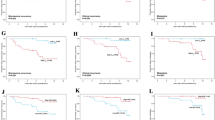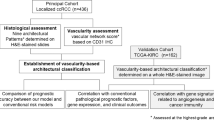Abstract
The objective of this work was to assess the correlation between microvessel density (MVD), pathological stage and disease recurrence in a series of patients who underwent radical prostatectomy for prostate cancer. Pathological material from 75 consecutive radical prostatectomies performed before 1994 without neo-adjuvant treatment, in which sufficient follow-up data were available, was re-examined. Paraffin embedded material was re-cut and hematoxylin and eosin (H&E) stained. Areas of maximal angiogenesis within tumor were identified. Expression of CD34 was investigated by using the monoclonal antibody MY 10. Within the areas of maximal angiogenesis, microvessels expressing CD34 were counted and specimens were divided into two groups, one showing a count of less than 90 microvessels per microscopic field at 200×magnification (MVD<90), the second more than 90 microvessels (MVD>90). The MVD was then related to pathological stage, Gleason score (GS) and outcome of the disease. Mean follow-up was 84 months. Clinical or biochemical progression was observed in 38.6% of patients. In low GS cases, MVD was always <90, whereas in GS 5–6, half had MVD <90 and half were >90. In high GS MVD was always >90. MVD was positively associated with a higher pathological stage. Progression of the disease was observed in 20% of MVD <90 and in 51% in MVD >90 (P=0.006). Mantel-Haensz test showed a correlation between MVD and time to progression (P<0.05). Although problems exist in methods of counting and in the cut-off number of vessels, which can discriminate the risk categories, it may be concluded that microvessel counts, using CD34 monoclonal antibody, can accurately predict the outcome of radical prostatectomy.
This is a preview of subscription content, access via your institution
Access options
Subscribe to this journal
Receive 4 print issues and online access
$259.00 per year
only $64.75 per issue
Buy this article
- Purchase on Springer Link
- Instant access to full article PDF
Prices may be subject to local taxes which are calculated during checkout



Similar content being viewed by others
References
Folkman J, Cotran R . Relation of vascular proliferation to tumor growth Int Rev Exp Pathol 1976 16: 207–248
Folkman J, Watson K, Ingber D, Hanahan D . Induction of angiogenesis during the transition from hyperplasia to neoplasia Nature 1989 339: 58–61
Fina L et al.. Expression of the CD34 gene in vascular endothelial cells Blood 1990 75: 2417–2426
Miettinen M, Lindenmayer A, Chaubal A . Endothelial cell marker CD31, CD34 and BNH9 antibody to H- and Y-antigens. Evaluation of their specificity and sensitivity in the diagnosis of vascular tumors and comparison with von Willebrand factor Modern Pathology 1994 7: 82–90
Weidner N, Semple JP, Welch WR, Folkman J . Tumor angiogenesis and metastasis. Correlation in invasive breast carcinoma New Engl J Med 1991 324: 1–8
Lansdorp PM, Sutherland HJ, Eaves CJ . Selective expression of CD45 isoforms on functional subpopulation of CD34+ hemo-poietic cells from human bone marrow J Exp Med 1990 172: 363–366
Civin CI et al.. Antigenic analysis of hematopoiesis. III. A hematopoietic progenitor cell surface antigen defined by monoclonal antibody raised against KG-1a cells J Immunol 1984 133: 157–165
Andrews RG, Singer JW, Bernstein ID . Precursor of colony-forming cells in humans can be distinguished from colony-forming cells by expression of the CD33 and CD34 antigens and light scatter properties J Exp Med 1989 169: 1721–1731
Srivastava A et al.. Neovascularization in human cutaneous melanoma: a quantitative morphological and Doppler ultrasound study Eur J Cancer Clin Oncol 1986 22: 1205–1209
Sillman F, Boyce J, Fruchter R . The significance of atypical vessels and neovascularization in cervical neoplasia Am J Obst Gynecol 1981 139: 154–159
Maeda K et al.. Tumor angiogenesis as a predictor of recurrence in gastric carcinoma J Clin Oncol 1995 13: 477–481
Macchianini P et al.. Relation of neovascularization to metastasis of non-small-cell lung cancer Lancet 1992 340: 145–148
Bigler SA, Deering RE, Brawer MK . Comparison of microscopic vascularity in benign and malignant prostate tissue Human Pathol 1993 24: 220–226
Arakawa A, Soh S, Chakraborty S, Wheeler TM . Prognostic significance of angiogenesis in clinically localized prostate cancer (staining for factor VIII-related antigen and CD34 antigen) Prostate Cancer Prostatic Diseases 1997 1: 32–38
Bettencourt MC et al.. CD34 Immunohistochemical assessment of angiogenesis as a prognostic marker for prostate cancer recurrennce after radical prostatectomy J Urol 1998 160: 459–465
Weidner N et al.. Tumor angiogenesis correlates with metastasis in invasive prostate carcinoma Am J Pathol 1993 143: 401–409
Brawer MK et al.. Predictors of pathologic stage in prostatic carcinoma Cancer 1994 73: 678–687
Silberman MA, Partin AW, Veltri RW, Epstein JI . Tumor angiogenesis correlates with progression after radical prostatectomy but not with pathologic stage in Gleason sum 5 to 7 adenocarcinoma of the prostate Cancer 1997 79: 772–779
De la Taille A et al.. Microvessel density as a predictor of PSA recurrence after radical prostatectomy Am J Clin Pathol 2000 113: 555–562
Acknowledgements
Research was supported by the educational grant 99/02 of Gruppo di Ricerca sul Cancro della Prostata, Varese, Italy.
Author information
Authors and Affiliations
Rights and permissions
About this article
Cite this article
Bono, A., Celato, N., Cova, V. et al. Microvessel density in prostate carcinoma. Prostate Cancer Prostatic Dis 5, 123–127 (2002). https://doi.org/10.1038/sj.pcan.4500572
Received:
Accepted:
Published:
Issue Date:
DOI: https://doi.org/10.1038/sj.pcan.4500572
Keywords
This article is cited by
-
Interleukin-30 subverts prostate cancer-endothelium crosstalk by fostering angiogenesis and activating immunoregulatory and oncogenic signaling pathways
Journal of Experimental & Clinical Cancer Research (2023)
-
Microvascular proliferation is associated with high tumour blood flow by mpMRI and disease progression in primary prostate cancer
Scientific Reports (2023)
-
Machine learning based on radiomics features combing B-mode transrectal ultrasound and contrast-enhanced ultrasound to improve peripheral zone prostate cancer detection
Abdominal Radiology (2023)
-
The natural compound atraric acid suppresses androgen-regulated neo-angiogenesis of castration-resistant prostate cancer through angiopoietin 2
Oncogene (2022)
-
Dietary tomato inhibits angiogenesis in TRAMP prostate cancer but is not protective with a Western-style diet in this pilot study
Scientific Reports (2021)



